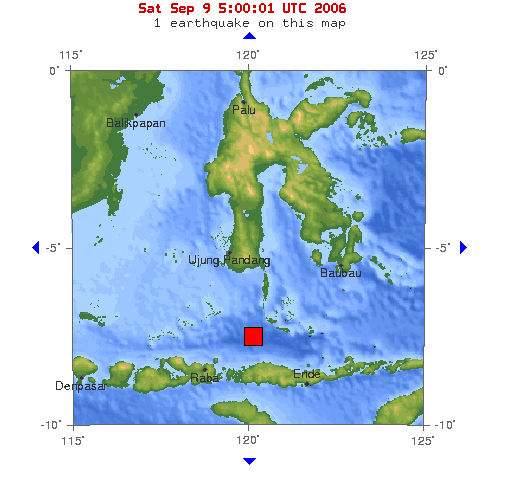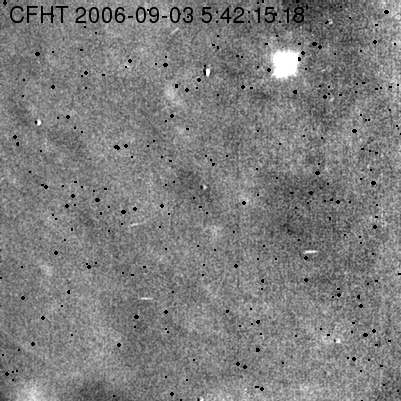USGS has reported a magnitude 6.2 quake in the Flores Sea, off Indonesia.
Category Archives: Physics
SMART-1 Goes Out With A Bang
Spacecraft down at 0542 GMT, the BBC says:
Astronomers are now analysing a plume of fresh lunar “soil”, or regolith, kicked up by the crash. They have also been looking for the bright flash as the probe hit the surface. The impact was expected to leave a 3m by 10m crater on the Moon’s surface, spreading debris over 78 sq km (30 sq miles).
The Planetary Society reports:
SMART-1 scientist Detlef Koschy confirmed that mission control lost the SMART-1 signal at 10:42:19. He reported that folks at ESOC applauded when the “mission ended just as planned.” Team members at ESOC are now downloading final pictures. SMART-1 took images up to about 5 minutes before impact.
Astrobiology Magazine reports:
The European Space Agency’s Smart-1 mission ended on September 3rd 2006, at 07:42 CEST (05:42 UT). Its final lunar resting place is located at 46.2º West longitude and 34.2º South latitude.
Update: the Canada France Hawaii Telescope on Mauna Kea has the following image of the impact!
SMART-1 Lunar Impact Coming Up Today
By my reckoning SMART-1 will impact the moon at 15:43 Melbourne time (also see the BBC report).
One of Our Planets is Missing
Farewell Pluto, now demoted to being merely a dwarf planet.
I guess we should think ourselves lucky it’s not red. 🙂
StarDust@Home Launches
Just reading the Planetary Society blog and saw a posting saying that the Stardust@Home project which I’ve written about previously has launched!
Go forth and find cool stuff.
Has Cassini Found Lakes on Titan At Last ?
The Planetary Society is reporting some really interesting news:
Saturn’s moon Titan was once thought to conceal a global ocean of methane and ethane beneath its smoggy atmosphere. However, while the landforms seen by Cassini and Huygens show ample evidence of past modification by the action of flowing liquids, actual bodies of present liquid have proven elusive through more than two years of investigation. Until now. During a July 22, 2006 flyby, Cassini’s RADAR instrument has finally unveiled what appears to be a land of lakes in Titan’s northern polar regions.
Pretty neat stuff, and this image is a neat example of some of the data they’ve got..
Inflatable Spacecraft in Orbit
New Scientist is reporting the successful launch of an inflatable spacecraft called Genesis 1 by Bigelow Aerospace which is a test of technology they’re working on to build various structures in space.
Bigelow themselves now have the first image from the spacecraft, a low-res thumbnail of the vehicle, saying:
We have extracted from early quick look data a low resolution thumbnail image of the Genesis I vehicle which verifies the success of vehicle inflation and solar array deployment. At this point in time, the vehicle is happy and healthy.

More news at their site here.
Space Titbits
Some interesting space stuff just spotted – double vortex spotted at Venusian south pole by Venus Express as well as imagery from Venus Expresses first orbit released by the ESA.
Also Saturn now has nine new moons discovered by a team using the Subaru 8.2-meter telescope. The Planetary Society blog post goes on to say:
If you’re keeping score, Jupiter is stil in the lead with 63 moons, but Saturn is running a close second now with 56. Uranus has 27 known moons and Neptune has 13, but both of those planets almost certainly have a lot more than anyone has spotted yet.
Tesla Down Under
No Nukes Please John
What Davyd said – hear hear.



